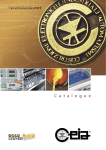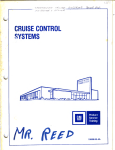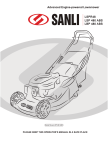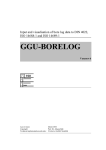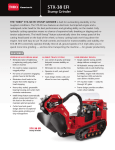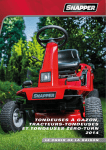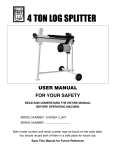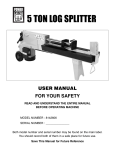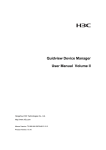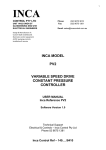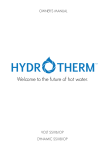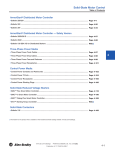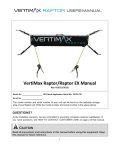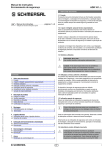Download Attention! - Romanoff - International Supply Corporation
Transcript
F1D Turbo • F3D • F4D • F5D • F9D • F12D --- Rev. FI 003 GB 8K2_3_14_16_17 v1.1 Electronic Metal Melting Machines F1-D Turbo • F3-D • F4-D • F5-D F9-D • F12-D Operator’s manual Serial number: ______________ Attention! Operate the Unit referring to the Technical Booklet having the same serial number of the Machine. Program Version: MFGC25xx MFG14xx Rev.: FI 003 GB 8K2_3_14_16_17 v1.1 Date: 29 / 03 / 2007 1 2 F1D Turbo • F3D • F4D • F5D • F9D • F12D --- Rev. FI 003 GB 8K2_3_14_16_17 v1.1 INSTRUCTIONS ATTENTION! READ THESE INSTRUCTIONS CAREFULLY BEFORE WORKING WITH THE DEVICE • • • • • • • • • • • • • • • • • • • • • • Read this booklet carefully before installing or operating the device and before carrying out maintenance operations. Keep this booklet in a safe place, for future reference. CEIA products may be operated with a high degree of safety provided that all the safety standards (following good sense and the manufacturer's advice) are observed. It is therefore essential that the heads of staff safety make sure that all operators read this manual before being allowed to use the device. At all times during the installation, use and maintenance of the device follow the guidelines presented in this booklet. CEIA will not be held responsible for any damage as a result of the device being used for purposed that are not expressly indicated in this booklet. Whenever there is the risk that the safety standards have been lowered, the device must be placed out of service in such a way that as to render its accidental usage impossible and assistance must be requested. The safety standards are to be considered lowered when: - the device shows visual signs of deterioration; - the device does not work correctly; - the device has been stored in less than satisfactory conditions for a long period of time; - the device has had to undergo severe strain during transportation; - the device has come into contact with liquid substances. The area directly surrounding the working zone must be supplied with adequate anti-incendiary devices. All combustible materials must be removed from the working zone and placed at a safe distance. Do not use excessive force during installation, use or maintenance of the device. The operator must be able to access the controls of the device easily, without running personal risks. Before providing the device with electrical power, check that the voltage from the power mains corresponds to the voltage shown on the device's electrical specifications plaque. Only connect the device to the power mains after having made all the connections needed for its complete installation. The electrical plug must only be inserted into a socket containing a grounding contact. Any interruption in the protective conductor either inside or outside the device, or the detaching of the protective grounding terminal, renders the device dangerous. Intentional interruption is forbidden. After melting, ensure that the metal that has been worked upon is allowed sufficient time to cool before handling it or bringing it into contact with combustible material. All electrical shocks are potentially fatal. Never touch parts charged with mains power. Keep clothes and body dry and never work in wet environments. Whenever one becomes aware that the device or part of it has accidentally become electrically charged, immediately stop the soldering operations and do not use the device until the problem has been located and resolved by qualified personnel. Wearers of electronic devices, such as pacemakers, must consult a doctor before coming into close contact with the device in order to ascertain whether the magnetic fields produced by high currents may influence the functioning of the pacemaker. Always remove the plug by hand when disconnecting the power supply cable, never by pulling on the cable. To prevent damage by lightening, disconnect the power supply cable during thunderstorms. Do not wash the device with water, liquid detergents or chemical substances. Use a slightly moist, non-abrasive cloth for cleaning. Never cut off the safety features of the device. Before any maintenance, cleaning or movement, the device must first be disconnected from all sources of power. Carefully read the "Maintenance" chapter of this booklet before contacting your service centre. In the event of a problem, only technicians that are specialized and authorized to work on CEIA machinery should be contacted. Any malfunctioning parts must be replaced with parts specifically designed for the device. It is important, as much as possible, to avoid carrying out maintenance or repairs on the device while it is open and supplied with electrical power; if absolutely essential, such work must be carried out only by qualified personnel who are well aware of the risks that are involved. The capacitors within the device may remain charged even after the device has been disconnected from all sources of power. Wait 60 seconds before beginning repair work on the device. Symbols The device is marked with this symbol whenever the operator or the maintenance personnel, in order to avoid possible damage, have to refer to the present manual. The same symbol appears in the booklet at points where warnings or particularly important instructions are given instructions that are vital to a safe and correct use of the device The device is marked with this symbol in those areas where a dangerous amount of voltage is present. Only specialized maintenance personnel should make adjustments in these areas. WARRANTY TERMS The Warranty on all CEIA equipment relates to goods delivered from our factory, under our general and specific conditions of sale. F1D Turbo • F3D • F4D • F5D • F9D • F12D --- Rev. FI 003 GB 8K2_3_14_16_17 v1.1 3 CONTENTS Page INSTRUCTIONS ..............................................................................................................................................................2 SYMBOLS .........................................................................................................................................................................2 WARRANTY TERMS .....................................................................................................................................................2 I - DESCRIPTION............................................................................................................................................................4 WORKING DIAGRAM AND DESCRIPTION ....................................................................................................................4 Crucibles .....................................................................................................................................................................6 TECHNICAL CHARACTERISTICS OF MELTING MACHINES F1-D-TURBO, F3-D, F4-D, F5-D, F9-D, F12-D............7 II - INSTALLATION .......................................................................................................................................................9 POWER SUPPLY..............................................................................................................................................................9 COOLING ......................................................................................................................................................................10 GAS TORCH ..................................................................................................................................................................10 Gas torch orientation ...............................................................................................................................................11 Air intake ferrule adjustment ....................................................................................................................................12 Checking correct adjustment of the gas torch on machines with optical temperature reader..................................12 Use of an auxiliary gas torch....................................................................................................................................12 METAL TEMPERATURE SENSOR ................................................................................................................................13 Thermocouple ...........................................................................................................................................................13 Dual-wavelength Optical Sensor ..............................................................................................................................13 III - INSTRUCTIONS FOR USE ..................................................................................................................................14 WORK CYCLE ..............................................................................................................................................................15 Halting processing ....................................................................................................................................................17 IV - MAINTENANCE ....................................................................................................................................................18 INSTRUCTIONS FOR PERIODIC MAINTENANCE ........................................................................................................18 Melting unit - Crucible..............................................................................................................................................18 Hydraulic unit ...........................................................................................................................................................19 Water filter............................................................................................................................................................................... 19 Closed-circuit system (MTA cooler)........................................................................................................................................ 19 Optical temperature sensor.......................................................................................................................................20 Procedure for checking the aim of the optical sensor............................................................................................................... 20 Instructions for replacing a thermocouple................................................................................................................21 FAULT SIGNALS ...........................................................................................................................................................23 Voice messages .........................................................................................................................................................23 Fault signalling on SELECTED TEMPERATURE display.......................................................................................23 Selection of voice message language ........................................................................................................................24 Entering the TCS700 optical sensor coefficient........................................................................................................25 V – LIST OF PARTS......................................................................................................................................................26 SPARE PARTS ...............................................................................................................................................................26 OPTIONS .......................................................................................................................................................................26 ACCESSORIES ..............................................................................................................................................................26 CONSUMABLES............................................................................................................................................................26 DECLARATION OF CONFORMITY CE ..................................................................................................................27 CEIA S.p.A. reserves the right to make changes, at any time and without prior notice, to models (including programming), to accessories and optional features, and to prices and conditions of sale. 4 F1D Turbo • F3D • F4D • F5D • F9D • F12D --- Rev. FI 003 GB 8K2_3_14_16_17 v1.1 I - DESCRIPTION Working diagram and description The working diagram of the Electronic Melting Machine is shown in Fig. I-1. The following sections are illustrated: 1) Control panel: this is located on the front of the device, and allows the operator to select the amount of power delivered and the operating temperature. 2) Medium-frequency generator: transforms the power supply voltage into medium-frequency energy, which drives the coil. The amount of energy supplied to the coil can be adjusted. 3) Coil: transforms the medium-frequency energy, provided by the medium-frequency generator, into a variable magnetic field. 4) Crucible: contains the metal to be melted; the crucible is heated by currents induced therein by the magnetic field generated by the coil. In order to obtain an efficient transfer of energy, the crucible is placed within the coil. 2 4 400V 3˜ (220V 3˜) MEDIUMFREQUENCY GENERATOR 1 Temperature sensor CONTROL PANEL Power adjustment Temperature adjustment Melting On/Off 3 Fig. I-1 Melting machine block diagram Control of the apparatus is entrusted to a microcomputer, which accepts instructions from the operator (switching on and off, adjustment of the power delivered and selection of melting temperature), checks that the machine is working correctly by means of a self-diagnostic device, and uses voice synthesis to give information about the melting of the metal and any action necessary on the part of the operator The power delivered, which depends on the temperature to be reached and the mass of the metal to be melted, can be adjusted digitally by the operator. The machine is also equipped with a thermoregulator with a pyrometer, via which the temperature the metal must reach during the melting phase can be set. The temperature sensor can be a dual-wavelength optical reader or an immersion thermocouple (for measurement ranges see the “Technical Characteristics” section). In addition to the power supply, the machine requires a water supply for the cooling system for the electronic power devices inside, connections for which are made on the left side of the machine The cooling water supply is monitored by a flowswitch, which prevents the machine from operating in the case of supply failure or low water flow-rate. The water temperature is controlled by a thermostat which blocks operation of the machine if overheating occurs. Figures I-2 and I-3 illustrate the electronic melting machines described in this manual. 5 F1D Turbo • F3D • F4D • F5D • F9D • F12D --- Rev. FI 003 GB 8K2_3_14_16_17 v1.1 SoP So CP So CG CP CR SoP CG CR PC PC CA TG TG CA MO Fig. I-2 models F1-D Turbo , F3-D and F4-D with optical temperature sensor (optional) H2O OUT PL Fig. I-3 models F5-D, F9-D and F12-D with optical temperature sensor (optional) CR MR RP S Ti H2O IN Fig. I-4a cooling water inlets and outlets. CA CG CP CR H2O IN H2O OUT S MO power supply cable gas torch crucible lid crucible water inlet water outlet coil container unit Fig. I-4b detail of the melting unit MR PC PL RP So SoP Ti TG Fig. I-4c detail of the immersion thermocouple refractory brick control panel crucible tongs refractory plate optic temperature sensor (optional) support of the optic temperature sensor immersion thermocouple (optional) label 6 F1D Turbo • F3D • F4D • F5D • F9D • F12D --- Rev. FI 003 GB 8K2_3_14_16_17 v1.1 fig. I-5 detail of the plaque, with the details of an F9-D melting machine. Crucibles The machines are supplied with graphite or silicon-graphite crucibles selected to provide optimum performance in terms of power delivered and melting quality. Their characteristics are set out below. In order to obtain the best possible results, we strongly recommend that only approved crucibles be used with CEIA melting machines. d b c f a g ) A B e Machine model F1-D F3-D F4-D F5-D F9-D F9-D Crucible model C1/G1 C3/G1 C4/G1 C5/G1 C9/G1 C9/S1 Code Type Capacity a b c d e f g 21463 2316 19230 2314 2315 14764 60cc 161cc 350cc 500cc 800cc 800cc 30 42 60 70 80 80 85 117 124 138 160 160 56 80 98 118 128 128 98 138 140 154 176 176 50 70 88 112 116 116 48 68 92 100 100 82 118 122 146 168 168 F12-D C12/G1 19611 graphite* graphite* graphite* graphite* graphite* silicon-graphite for high temperatures** graphite* 980cc 90 155 140 180 130 108 170 * recommended for operating temperatures up to 1200°C ** recommended for operating temperatures up to 1600°C fig. I-6 available crucibles; A: crucible; B: refractory container TABLE OF SPECIFIC WEIGHTS OF SOME METALS Al 2.56 Ag 10.53 Cd 8.60 Ni 8.40 Au 19.26 Pd 11.40 Cu 8.85 Rh 12.10 Zn 6.86 SPECIFIC WEIGHT AT DIFFERENT FINENESSES Au 750‰ 585‰ 417‰ 375‰ 333‰ 917‰ 18KT 14KT 10KT 9KT 8KT 22KT 15.54 13.04 11.70 10.82 10.75 17.82 Ag 925‰ 835‰ Ag. Ag. 10.37 10.28 7 F1D Turbo • F3D • F4D • F5D • F9D • F12D --- Rev. FI 003 GB 8K2_3_14_16_17 v1.1 800‰ Ag. 10.20 Technical characteristics of melting machines F1-D-Turbo, F3-D, F4-D, F5-D, F9D, F12-D Dimensions (width x depth x height) Machine weight Maximum absorbed power Maximum output power 4,5 kVA 50 kVAR 63 kg 63 kg F1-D-Turbo/220 1kg Power supply voltage (three-phase 50/60 Hz) 200 - 240 V F1-D-Turbo/400 1kg 360 - 440V 4,5 kVA 50 kVAR F3-D/220 2,8kg 200 - 240 V 4,5 kVA 50 kVAR F3-D/400 2,8kg 360 - 440V 4,5 kVA 50 kVAR 63 kg F4-D/220 6kg 200 - 240 V 5,5 kVA 60 kVAR 63 kg F4-D/400 6kg 360 - 440V 5,5 kVA 60 kVAR 63 kg F5-D/220 8,6 kg 200 - 240 V 7 kVA 80 kVAR 133 kg F5-D/400 8,6 kg 360 - 440V 7 kVA 80 kVAR 90 kg F9-D/220 13,5 kg 200 - 240 V 9,5 kVA 95 kVAR F9-D/400 13,5 kg 360 - 440V 9,5 kVA 95 kVAR 90 kg F12-D/220 17 kg 200 - 240 V 12 kVA 115 kVAR 140 kg F12-D/400 17 kg 360 - 440V 12 kVA 115 kVAR 90 kg Operating capacity in pure gold Model 430x450x905 mm 575x580x905 mm 63 kg 133 kg Metal melting temperature: selectable thanks to a digital thermoregulator and pyrometer with an immersion thermocouple or an optical sensor (optional). Measurement range: - K-type thermocouple : 150÷1300 °C. * - optical sensor: 700÷2000 °C. * The maximum value should not be considered applicable for continuous use. We recommend that operational temperatures should be at least 150°C below these values. Water cooling: via a tank witha 0.5 Hp pump, or via a direct supply at the pressure indicated in the table below: intermittent working (50%) tank capacity pump power direct supply pressure flow continuous working (<1300°C) F1-D-Turbo • F3-D • F4-D F5-D F9-D F12-D 200 l 0.5 Hp 300 l 0.5 Hp 300 l 0.5 Hp 500 l 0.5 Hp 200-600kPa > 2 l/min 200-600kPa > 22.5 l/min 200-600kPa > 2.5 l/min 200-600kPa > 2.5 l/min 500 l 0.5 Hp 750 l 0.5 Hp 750 l 0.5 Hp 1000 l 0.5 Hp 200-600kPa > 2 l/min 200-600kPa > 2.5 l/min 200-600kPa > 2.5 l/min 200-600kPa > 2.5 l/min tank capacity pump power direct supply pressure flow Inlet: 3/4" screw fitting; Outlet: hose fitting, ø12mm Safety features Monitoring of thermocouple operation. Monitoring of cooling-water temperature and flow. Monitoring of all phases of the power supply. 8 F1D Turbo • F3D • F4D • F5D • F9D • F12D --- Rev. FI 003 GB 8K2_3_14_16_17 v1.1 Monitoring of the power supply voltage, for both excess and insufficient voltage. Special features Very high efficiency: fast melting with the minimum energy consumption. No generator maintenance required. Consistent melting results thanks to microprocessor control. Digital selection and control of the power and melting temperature. Monitoring of wear on crucible. Automatic cut-out if crucible is missing. Self-diagnosis with messages by voice synthesis and display indication. Accessories supplied • • • • • Options Gas torch: useful to avoid metal oxidation during melting. Installed on the induction melting machine plate, in order to let the flame spread on the crucible. Crucible Crucible cover Crucible tongs Water circuit connection pipes: length 4 m. TCS700-LPD Optical Temperature Sensor: this can replace a thermocouple sensor, and has the following advantages: • temperature measurement without contact • no inertia, so allowing precision and reliability of reading • no sensor maintenance • no problem of metal contamination during melting caused by damage to the thermocouple sheath Sensor accuracy is not influenced by the metal state or type, nor by the presence of smoke. Immersion thermocouple Measurement range: - K-type thermocouple : 150÷1300 °C. * * The maximum value should not be considered valid for continuous use. We recommend that operational temperatures should be at least 150°C below this value. MTA 10 Cooling unit: Characterized by its compact dimensions and equipped with digital regulating, it allows continuous operation for standard melting (temperatures below 1300°C), maintaining the temperature of the cooling water at the optimum level of 25°C. Cooling capacity: 3.31 kW MTA 20 Cooling unit: Characterized by its compact dimensions and equipped with digital regulating, it allows continuous operation for standard melting (temperatures below 1300°C), maintaining the temperature of the cooling water at the optimum level of 25°C. Cooling capacity: 6.94 kW 9 F1D Turbo • F3D • F4D • F5D • F9D • F12D --- Rev. FI 003 GB 8K2_3_14_16_17 v1.1 II - INSTALLATION In this chapter the procedure for correct installation and maintenance of the machine is explained. In the event that further information or clarification is required, customers are requested to contact the Technical Department of C.E.I.A. It should be noted that C.E.I.A. is not responsible for any damage that may result from installations that do not follow the guidelines laid down in this chapter. Power supply Connect the machine to earth/ground and to the voltage indicated on the plate and in the CONFIGURATION sheet (at the end of the manual), using the power supply cable. The line conductors should have a minimum section equal to those specified in the CONFIGURATION sheet: For the standard model with 380-400V power supply the line conductors should have: • a minimum section of 4 mm2 • a 16A-rated socket (models F1-D ... F5-D) or a 32A-rated socket (models F9-D ... F12-D ) For the model with 208-230V power supply the line conductors should have a minimum section of 6 mm2 and a 50A-rated socket. N.B.: in this case the power supply cable is not fitted with a plug. The conductor key is as follows: Function fig. II-1 L1 L2 L3 Earth/Ground Conductor colour (EUROPE) (USA) blue brown black yellow/green black red orange green 10 F1D Turbo • F3D • F4D • F5D • F9D • F12D --- Rev. FI 003 GB 8K2_3_14_16_17 v1.1 Cooling Feed "H2O IN" plant with water from from a water system or from a zinc-coated steel tank (see Technical characteristics). N.B. It is important to ensure that the temperature of the water entering the machine does not exceed 40° C. The water-supply must be controlled, upstream, by a safety cock. If a tank is used (Fig. II-1) the pump will take water from the bottom of the tank, while the water returning to the tank from the machine will be deposited at the top of the tank. Connect the water drain "H2O OUT"(Important: do not invert load and drain). S H2O OUT R fig. II-2 P H2O IN S: tank; R: water cock; P: pump The liquid of the cooling unit must be water only, without additives, anti-freeze, anti-calcium agents, salts, etc. In order to allow proper heat transfer from the water to the environment, do not use a tank in insulating material (plastic, fiberglass, etc.). Gas Torch We recommend fitting the crucible with a gas torch which will prevent the metal oxidation and will lengthen the life of the crucible. This accessory is fitted directly onto the melting machine work-surface, and orientated so that the flame completely envelops the crucible opening. fig. II-3 Upstream of the gas torch, install a valve to bring the pressure to 200÷300 kPa. Flame adjustment is made by balancing the intake of air (using the Fs locking ring and Ra regulator) and the gas flow (using the Rg tap). F1D Turbo • F3D • F4D • F5D • F9D • F12D --- Rev. FI 003 GB 8K2_3_14_16_17 v1.1 11 2 Tg Rg Ra Ug Fs Cg 1 fig. II-4a - Cg gas cannula; Rg gas tap; Fs locking ring; Tg hose for inflow of gas; Ra air adjuster; Ug nozzle fig. II-4b - Nozzles included: 1: methane or town gas nozzle; 2: propane gas nozzle ATTENTION! The nozzle Ug of the gas torch must be changed depending on the gas used: GAS Propane Methane or Town gas ø nozzle 0.4mm 2,2mm Gas torch orientation The orientation must enable the flame to envelop the crucible mouth completely. If the Melting Machine is fitted with an optical pyrometer, the gas torch must be positioned correctly and the air flow properly adjusted, otherwise the pyrometer will measure the flame temperature rather than the metal temperature during melting. The figures below show the proper position of the gas torch: the flame must be aimed towards the rear rim of the crucible and must create a whirl over the crucible mouth. YES! 4 NO! 3 1 1 2 2 fig II-5:. 1: gas torch; 2: crucible; 3: air adjustment; 4: optical sensor. 12 F1D Turbo • F3D • F4D • F5D • F9D • F12D --- Rev. FI 003 GB 8K2_3_14_16_17 v1.1 Air intake ferrule adjustment The locking ring 3 must be adjusted so as to obtain a blue flame as far as the rim of crucible and a yellowred one when over the crucible mouth. Checking correct adjustment of the gas torch on machines with optical temperature reader • Turn the melting machine on at the main switch; place a crucible at room temperature in the melting unit; do not start the melting process. • Light the gas: if the position and the air adjustment are correct, the thermoregulator should indicate --- a temperature below the measurement range ( display symbol ). Use of an auxiliary gas torch Do not use an auxiliary gas torch, as the pyrometer might read the gas temperature instead of the metal temperature: always keep the torch on the same side as the optical sensor. NO! YES! 3 3 1 1 2 fig. II-6 . 1: gas torch; 2: crucible; 3: optical sensor. 2 13 F1D Turbo • F3D • F4D • F5D • F9D • F12D --- Rev. FI 003 GB 8K2_3_14_16_17 v1.1 Metal temperature sensor Two types of temperature sensor can be installed on the electronic melting machine: Thermocouple Fix the two thermocouple supports St to the surface of the unit, on the right-hand side of the machine, using the screws supplied. Connect sensor cable C to the Ct connector on the side of the unit and rest the sensor on the supports. C Ti Ct St fig. II-7 Ti: thermocouple; St: thermocouple supports; C: thermocouple cable ; Ct: sensor cable connector Dual-wavelength Optical Sensor Fix the tubular support SoP to the surface of the machine: the sensor So will point at the crucible's interior automatically. Then connect the sensor cable to connector Ct. C c C SoP So SoP fig. II-8 So: optical sensor; C optical sensor cable; Ct: optical sensor connector DO NOT CHANGE the orientation of the sensor-cylinder So ! Ct 14 F1D Turbo • F3D • F4D • F5D • F9D • F12D --- Rev. FI 003 GB 8K2_3_14_16_17 v1.1 III - INSTRUCTIONS FOR USE CEIA will not accept any responsibility for improper or negligent use, or for use which does not comply with the rules laid down in this user’s manual. Before each melting operation • Crucible wear and tear Before each melting operation the condition of the crucible should be checked: if there are areas that have suffered damage the crucible should be replaced with a new one. • Noxious fumes Additives and some alloys may produce noxious fumes during melting: all necessary measures should therefore be taken to protect the health of the operator. • Additives Do not put into the crucible compounds or materials which may produce phenomena harmful to persons or property during operation and use of the melting machine. CEIA will not accept any responsibility for improper or negligent use, or for use which does not comply with the rules laid down in this user’s manual. • Crucibles During the first melting operation, crucibles must be subjected to a gradual temperature increase, to allow evaporation of any moisture which may have been absorbed. It is advisable to keep crucibles near a source of heat to avoid the absorption of environmental humidity. Check periodically, and always after moving the melting machine, that the coil is perfectly centred, in order to avoid undue wear on the coating of the coil itself due to the friction of the crucible • Metal temperature Do not overheat the metal to temperatures significantly above that of melting, so as to avoid splashing of incandescent metal and the consequent risk of damage to persons or property. CEIA will not accept any responsibility for improper or negligent use, or for use which does not comply with the rules laid down in this user’s manual. • Cooling system The cooling unit must be supplied with water only, without additives, anti-freeze, anti-calcium agents, salts, etc. • Cooling system If the melting machine cooling system is connected directly to a water mains outlet, the hydraulic unit should be cleaned every six months (see Maintenance section) • Optical temperature sensor During operation the lens of the sensor may become dirty due to dust or smoke: it should be cleaned at least once a week. The melting machine is equipped with a magnetothermal MAIN SWITCH, located on the control panel. This switch serves as a protection against malfunctions. F1D Turbo • F3D • F4D • F5D • F9D • F12D --- Rev. FI 003 GB 8K2_3_14_16_17 v1.1 15 Work Cycle 1 2 3 4 11 6 5 7 9 1 2 3 4 5 6 8 10 LED power indicator Measured temperature Indicator of power delivered Selected temperature Power decrease button Power increase button 7 8 9 10 11 Selected temperature decrease button Selected temperature increase button Melting process Stop button Melting process Start button Main switch fig. III-1 detail of the control panel • Supply the correct voltage (see values indicated on the plate attached to the rear of the unit) and water. • Turn on the MAIN SWITCH: - the "LINE" indicator comes on - the POWER display indicates the device’s software version (2-figure sequence) - the SELECTED TEMPERATURE display indicates the selected melting temperature • When the melting machine is operative, the status of the indicators is as follows:: --on -- 1051 model with temperature sensor • --model without temperature sensor Place the crucible in position. Absence of the crucible is noticed by the machine when the button is pressed; if this happens, the machine switches itself off and gives the message "Crucible missing". Avoid melting when the crucible is very worn, as the crucible heats more slowly and the apparatus might not reach its normal operational rating ) The melting machine is delivered with the voice messages in the language indicated on the CONFIGURATION sheet at the end of the manual. To activate a different language, follow the procedure described in the MAINTENANCE section. 16 F1D Turbo • F3D • F4D • F5D • F9D • F12D --- Rev. FI 003 GB 8K2_3_14_16_17 v1.1 • If the crucible is too worn, the message "Attention - replace crucible" is given a few seconds after the machine is switched on; after this message, the machine will continue to work as long as there is no immediate danger to the apparatus. Here it must be noted that in continuing to use a worn-out crucible, one runs the risk of it breaking during melting, which could cause serious injury to the operator or damage to the machine. CEIA will not accept any responsibility for improper or negligent use, or for use which does not comply with the rules laid down in this user’s manual. • Insert the metal into the crucible, taking care not to scratch the sides and calculating the quantity so that during the melting stage it will remain a few centimetres below the rim of the crucible. This allows it to be stirred using a graphite rod, and thus a constant fineness of product can be obtained. • Melting additives For quicker, better melting, use additives such as boric acid; the resulting deposit can easily be removed with a graphite rod when melting is completed. • (increase) and Adjust the melting temperature using the indication on the SELECTED TEMPERATURE display will change. • Press the • During melting, the POWER display shows the power delivered by the generator: the generator is switched on and off automatically to keep the melting temperature constant. When the generator is off, button (green) to start the melting process. the display shows the message ) (decrease) buttons: the -- . When the button is pushed and during the heating phase, a short audible signal is emitted at intervals of about 30” to indicated that the melting machine is in operation. • (increase) and Adjust the power to the desired value using the the POWER display indication with flash during adjustment. • Metal temperature control Thermocouple When metal is on the point of melting, start the temperature control by inserting the thermocouple into the crucible. IMPORTANT: after insertion of the probe, the temperature sensor takes some time to reach thermal equilibrium with the crucible; in this situation the pyrometer reading is not completely reliable and the temperature of the crucible will not correspond exactly to that programmed. If one wants to be certain of the working temperature of the metal, it is necessary to wait till the thermoregulator is stabilized: this is indicated by the frequency with which the pyrometer is activated, which initially is of the order of every few minutes, but when balance is reached is of the order of every few seconds. (decrease) buttons: When the immersion thermocouple reaches high temperatures or is subjected to sudden fluctuations in temperature, it becomes mechanically weak: in this situation, handle the thermocouple with care, and avoid impacts agaist the melting machine casing or other hard surfaces. Optical temperature sensor This is aimed at the crucible'sinterior. If a cover is necessary, remember that it darkens the crucible. Due to the lack of inertia, the pyrometer will show a valid measurement of the metal's temperature when the cover is taken off. If the optical sensor malfunctions, refer to the notes in the “MAINTEANCE” section. F1D Turbo • F3D • F4D • F5D • F9D • F12D --- Rev. FI 003 GB 8K2_3_14_16_17 v1.1 • 17 Gas torch If a gas torch is used to avoid oxidation of the metal, keep the flame on the crucible for the entire duration of the melting. It is advisable to use an auxiliary gas torch during the casting phase. Before removing the crucible during melting, stop the machine by pressing the button(red) Halting processing • After use, turn off the MAIN SWITCH. Disconnect the mains supply. Before closing the water cock or disconnecting the pump, wait till the crucible has completely cooled or take the crucible out. ) To prolong the life of crucibles, we recommend that it is removed from the machine when work is finished and allowed to cool slowly with a cover on, in order to reduce thermic shock. It is a good idea to put in some boric acid in this case, as the acid vaporizes during the cooling phase and, as it is in a closed container, causes convection which helps to distribute it uniformly over the inside of the crucible. 18 F1D Turbo • F3D • F4D • F5D • F9D • F12D --- Rev. FI 003 GB 8K2_3_14_16_17 v1.1 IV - MAINTENANCE Any maintenance or repair to the machine must only be carried out after the power supply cable has been disconnected. CEIA will not accept any responsibility for improper or negligent use, or for use which does not comply with the rules laid down in this user’s manual. Instructions for periodic maintenance Melting unit - Crucible It is very important to check the condition of the crucible before every melting operation. Here it must be noted that in continuing to use a worn-out crucible, one runs the risk of it breaking during melting, which could cause serious injury to the operator or damage to the machine. CEIA will not accept any responsibility for improper or negligent use, or for use which does not comply with the rules laid down in this user’s manual. In the event that the melting device is under-powered (indication lower than 70% of maximum power), it is recommended that the crucible be replaced (information given by the machine in the form of a voicesynthesized message). To prolong the life of crucibles, we recommend that they are allowed to cool slowly with a cover on, in order to reduce thermal shock. It is advisable to put in some boric acid in this case, as the acid vaporizes during the cooling phase and, as it is in a closed container, causes convection, which helps to distribute it uniformly over the inside of the crucible. The parts that make up the melting unit are illustrated in Fig. IV-1. It is recommended that weekly checks are made on the condition and correct positioning of these parts, and in particular of the condition of the coil insulation. CR CP MR PL RP S Fig. IV-1 Melting unit components Rif. RP MR CR CP PL S ) Description Refractory plate Refractory brick Graphite crucible with refractory container Refractory crucible cover Tongs Heating inductor In order to obtain the best possible results, we strongly recommend that only approved crucibles be used with CEIA melting machines. F1D Turbo • F3D • F4D • F5D • F9D • F12D --- Rev. FI 003 GB 8K2_3_14_16_17 v1.1 19 Hydraulic unit The liquid supplied to the cooling unit must be water only, without additives, anti-freeze, anti-calcium agents, salts, etc . For closed-circuit systems, distilled water should be preferred. To avoid periodic cleaning of the cooling system, we recommend that a closed-circuit system with distilled water be used. With the use of non-distilled water, the tubes of the hydraulic cooling unit are subject to the build-up of calcium sediment. As a result, one or more sections of the tubes may become totally or partially blocked . If this occurs, a partial block stops the water from flowing smoothly, causing overheating: the machine control system interrupts the melting and signals a malfunctioning with a vocal message. A total block stops the flow of water: again, the machine control system interrupts the melting and signals a malfunctioning with a vocal message. If blocking of the unit occurs, a complete check and manual cleaning of each component of the cooling unit should be carried out (rubber tubing and power modules). It is advisable to disconnect one tube at a time, to avoid the risk of mistakes in re-assembly It is important that cleaning of the cooling unit be carried out with the machine switched off in order to avoid the danger of injury to the operator After the above operation, however, it is still advisable to carry out the periodic cleaning. It is recommended that cyclical cleaning be carried out every six months. The cleaning operation is carried out by means of a series of washes of the unit with a solution of water and solvay soda and continues until the tubes are completely clean. Water filter The water intakes " H2O IN " are equipped with a filter net to ensure that any impurities in the water do not get into the cooling system and impede the flow. Check regularly that this filter is not blocked. Fig. IV-2a Detail of the water inlet fitting Fig. IV-2b Water inlet fitting components Taking out the filter Closed-circuit system (MTA cooler) The system does not need any maintenance apart from periodic topping-up of the liquid. N.B.: Use only distilled water for topping up! If distilled water is not used, the instructions in the section above should be followed. 20 F1D Turbo • F3D • F4D • F5D • F9D • F12D --- Rev. FI 003 GB 8K2_3_14_16_17 v1.1 Optical temperature sensor If the thermoregulator does not measure variations in the temperature during melting operations, or the reading is erroneous, check that the sensor is aimed correctly and that the lens is clean. Also check that the gas torch is not directed toward the sensor during use (see Installation section). Clean the sensor lens periodically. The lens can be cleaned with a cotton-tipped stick dipped in alcohol. It is advisable to carry out this cleaning every six months. Procedure for checking the aim of the optical sensor Switch the main switch to the ON position Press the START button ---- Wait for the temperature read-out to exceed 800°C. 832 Or = 18 BS Press the START button for at least 5 seconds: the message “Or =” appears on the CRUCIBLE TEMPERATURE display, whilst the SELECTED TEMPERATURE display shows a number which updates every second. Loosen the sensor locking screw BS and find the position which gives the maximum reading on the SELECTED TEMPERATURE display. This figure should generally be > 15. Lock the sensor again. Press the STOP button to return to normal operation. Fig. IV-3 F1D Turbo • F3D • F4D • F5D • F9D • F12D --- Rev. FI 003 GB 8K2_3_14_16_17 v1.1 21 Instructions for replacing a thermocouple If the sensor fails, the thermoregulator stops the machine in order to save the metal being treated. The digital temperature controller will show an error message. The thermocouple may stop functioning for one of two reasons: 1) The stainless steel protective sheath for the conductors in Cr-Al has become worn. 2) The working temperature has gone beyond the maximum limit of 1300°C causing fusion of the above-mentioned components. Correct operation of the thermocouple can be verified by checking the thermocouple terminals after having removed it from the machine. The Ohm value displayed by the multimeter (a scale of Ohm x 10) must be close to zero, which indicates uninterrupted operation. (To access the terminals see step 2 of the procedure given below). Another check is to verify that the external sheath is insulated from one of the thermocouple terminals (once again by using the multimeter); that is to say, the tube in stainless steel must be insulated from the head in Cr-Al. In this case the resistance must be above 10 MOhm. Should the test results not correspond to the abovementioned values, the thermocouple must be replaced. To do so follow the procedure given below. 1) Unscrew the locking ringlet A, which frees the external protective sheath B from the thermocouple. Unscrew the joint C. 2) Remove the screws E which seal the outside cover D. Fig. IV-4a 22 F1D Turbo • F3D • F4D • F5D • F9D • F12D --- Rev. FI 003 GB 8K2_3_14_16_17 v1.1 3) Remove the fixing screws G for the ceramic terminal-support H and loosen the terminalsupport in such a way that it can be rotated. Free connecting cable J by loosening screws F and ring nut K and then remove this cable. The correspondence between the conductors and the terminals is shown below: green conductor (v) - red terminal(r) red conductor (r) - yellow terminal(g) 4) Rotate the square joint L anti-clockwise until it can be removed from the support tube. 5) Bend the rear of the thermocouple M into a wide curve and carefully remove the square joint L. 6) Straighten the sheath M and pull it out of the support tube. 7) Insert the new thermocouple M, with its ceramic support H into the support tube and reassemble by following the above-mentioned procedure in reverse. Fig. IV-4b F1D Turbo • F3D • F4D • F5D • F9D • F12D --- Rev. FI 003 GB 8K2_3_14_16_17 v1.1 23 Fault signals Voice messages The melting machine is fitted with an effective system of self-diagnosis which notifies the operator when some parts of the apparatus malfunction. Messages relating to this self-diagnosis are as follows: " Attention - water temperature too high" " Attention - insufficient water pressure" " Attention - one phase missing" " Attention, crucible missing" " Attention - replace crucible " “ Attention – high voltage” “ Attention – interrupted thermocouple” “ Attention – internal fault” This is a continuous check. The machine turns itself off and will not accept further instructions until the situation changes (T < 65°C). This is a continuous check. The machine turns itself off and will not accept further instructions until the situation changes. Check that the water flow corresponds to that shown in the “Technical Characteristics” section. The message is also given when the tubing is obstructed by calcium deposits - in this case the water cooling system must be cleaned. This is a continuous check, and warns the operator that the three-phase power circuit is unbalanced and will therefore not allow the machine to work properly. The machine will not accept instructions until the situation returns to normal. is Absence of the crucible is noticed by the machine when button presed; if this happens, the machine switches itself off and gives the message. If the crucible is too worn, the message is given a few seconds after the machine is switched on; after this message, the machine will continue to operate as long as there is no immediate danger to the apparatus. Here it must be noted that in continuing to use a worn-out crucible, one runs the risk of it breaking during melting, which could cause serious injury to the operator or damage to the machine. CEIA will not accept any responsibility for improper or negligent use, or for use which does not comply with this warning. This is a continuous check. The machine turns itself off and will not accept further instructions until the correct voltage supply resumes. Check the thermocouple and replace if necessary. If the spare part is not immediately available,disconnect the thermocouple cable from connector Ct on the side of the casing. Contact CEIA technical service personnel. Fault signalling on SELECTED TEMPERATURE display Fault code Er1 Er2 Er3 Cause Crucible missing Internal fault Insufficient water flow Er4 Er5 Internal fault High water temperature Er6 Er7 Er8 Er9 One phase missing interrupted thermocouple Low voltage High voltage Action Put the crucible in. Contact CEIA technical service personnel. • Check the water supply outlet • Check the H2O IN filter Contact CEIA technical service personnel. Check the temperature of the water entering the machine Check power supply connections Check the thermocouple and replace if necessary. Check the power supply voltage Check the power supply voltage If the machine malfunctions without giving a diagnostic message, please contact C.E.I.A. 24 F1D Turbo • F3D • F4D • F5D • F9D • F12D --- Rev. FI 003 GB 8K2_3_14_16_17 v1.1 Selection of voice message language 1. To enter programming, switch the MAIN SWITCH to ON while holding down the P key. + + L9 = 1 1. The code of the Lg (language) parameter appears on the CRUCIBLE TEMPERATURE display, while the number of the currentlyselected language appears on the SELECTED TEMPERATURE display. 2. Press key E to enter modification phase: the number on the SELECTED TEMPERATURE display will begin to flash. 2. Modify the value of the setting using the power 2 adjustment keys 1 2 3 4 5 6 + and -, according to the table: Italiano English Français Deutsch Español Turkish 5. Press key E (or P) to leave the parameter modification phase: the number on the SELECTED TEMPERATURE display will stop flashing. 6. Press key P to exit programming. Fig. IV-5 F1D Turbo • F3D • F4D • F5D • F9D • F12D --- Rev. FI 003 GB 8K2_3_14_16_17 v1.1 25 Entering the TCS700 optical sensor coefficient Every TCS700 optical sensor has a numerical coefficient which determines its accuracy of measurement. If an optical sensor is replaced, or fited to a melting machine as an upgrade kit, this coefficient must be assigned to the OC operating parameter. 1. To enter programming, switch the MAIN SWITCH to ON while holding down the P key. + + L9 = 1 OC = 2. The code of the Lg (language) parameter appears on the CRUCIBLE TEMPERATURE display, while the number of the currentlyselected language appears on the SELECTED TEMPERATURE display. 1. Press power adjustment keys (decrease) until you get command. (increase) or to the OC 1000 2. Press key E to enter modification phase: the number on the SELECTED TEMPERATURE display will begin to flash. 3. Modify the value of the setting using the power 997 adjustment keys + and -. 5. Press key E (or P) to leave the parameter modification phase: the number on the SELECTED TEMPERATURE display will stop flashing. 6. Press key P to exit programming. Fig. IV-6 26 F1D Turbo • F3D • F4D • F5D • F9D • F12D --- Rev. FI 003 GB 8K2_3_14_16_17 v1.1 V – LIST OF PARTS Spare parts Modell F1-D Turbo/ 220 F1-D Turbo / 400 F3-D/ 220 F3-D/ 400 F4-D/ 220 F4-D/ 400 F5-D/ 220 F5-D/ 400 F9-D/ 220 F9-D/ 400 F12-D/ 220 F12-D/ 400 Generator MFG-F3/220 Generator MFG-F3/400 Generator MFG-F4/220 Generator MFG-F4/400 Generator MFG-F5/220 Generator MFG-F9/400 Generator MFG-F12/400 Power module D Control panel complete with display card 00800SDP Temperature sensor connection card 00800SGN Heating inductor Main switch Surface in refractory material Brick in refractory material Gas torch Optical pyrometric sensor Support arm for optical sensor Crucible cover Crucible tongs 19505 19244 19247 19506 19244 19247 19505 19244 19247 19506 19244 19247 19507 19244 19247 19508 19244 19247 19509 19244 19248 19509 19244 19248 19510 19244 19248 19510 19244 19248 19609 19244 19248 19609 19244 19248 19243 19243 19243 19243 19243 19243 19243 19243 19243 19243 19243 19243 19596 19596 19116 19116 19127 19127 19128 19128 19129 19129 19608 19608 19249 19246 19249 19246 19249 19246 19592 19246 19592 19249 19592 19249 20219 20219 7775 7775 19193 19193 9849 9849 9835 9835 19617 19617 9876 9876 9876 9876 9876 9876 14960 14960 14960 14960 14960 14960 4045 4045 4045 4045 4045 4045 4047 4047 4047 4047 4047 4047 TCS700 TCS700 TCS700 TCS700 TCS700 TCS700 TCS700 TCS700 TCS700 TCS700 TCS700 TCS700 19250 19250 19250 19250 19250 19250 19250 19250 19250 19250 19250 19250 12078 12078 2176 12079 2176 12079 19889 14448 19889 14438 2177 12080 2177 12080 2177 12081 2177 12081 2177 19619 2177 19619 Options K-type thermocouple 19241 Complete optical pyrometric sensor TCS700-LPD Accessories Model 300 litre zinc-coated steel tank with 0.37kW 230V˜ pump 500 litre zinc-coated steel tank with 0.37kW 230V˜ pump 300 litre stainless-steel tank with 0.37kW 230V˜ pump 300 litre zinc-coated steel tank with 0.37kW 400V˜ pump 500 litre zinc-coated steel tank with 0.37kW 400V˜ pump 300 litre stainless-steel tank with 0.37kW 400V˜ pump Cooler MTA10 220-240V 1˜ F1-D Turbo/ 220 • F3-D/ 220 • F4-D/ 220 F5- F1-D Turbo/ D/ 220 • F9-D/ 220 • F12-D/ 220 400 F3-D/ 400 F4-D/ 400 F5-D/ 400 300L-230 - 500L-230 - 300L-230AQ - - 300L-400 - 500L-400 - 300L-400AQ Cooler MTA20 380-415V 3˜ F9-D/ 400 F12-D/ 400 - 6309 6309 6309 6309 6309 - - - - - - - 6308 Consumables Model F1-D Turbo / 220 • F1-D Turbo / 400 F3-D/ 220 F3-D/ 400 F4-D/ 220 F4-D/ 400 F5-D/ 220 F5-D/ 400 F9-D/ 220 F9-D/ 400 F12-D/ 220 F12-D/ 400 Graphite crucible 21463 (C1/G1) - 2316 (C3/G1) 2176 19230 (C4/G1) 19889 2314 (C5/G1) 2177 2315 (C9/G1) 14764 (C9/S1) 2177 19611(C12/G1) 2177 Silicon-Graphite crucible Crucible cover F1D Turbo • F3D • F4D • F5D • F9D • F12D --- Rev. FI 003 GB 8K2_3_14_16_17 v1.1 DECLARATION OF CONFORMITY CE DECLARATION OF CONFORMITY CE DECLARATION DE CONFORMITE CE KONFORMITÄTSERKLÄRUNG CE DECLARACION DE CONFORMIDAD CE DICHIARAZIONE DI CONFORMITÁ CE Manufacturer Fabricant / Hersteller / Fabricante / Costruttore: CEIA S.p.A. Zona industriale Viciomaggio 54/G 52040 Viciomaggio - Arezzo - ITALY Declares that the product déclare que ce produit / erklärt, daß das Produkt / declara que el producto / dichiara che il prodotto: Product name: Nom du produit: / Produktname: Nombre del producto: / Nome: Model Série / Serie Serie / Modello: F1-D-TURBO F5-D D Melting machine Fondeuse a moyenne fréquence / Schmelzofen Fundidora electrónica de metales / Fonditrice ad induzione F3-D F9-D F4-D F12- all model tous modèles/ alle Modelle todos los modelos/ tutti i modelli conforms to the following Product Specifications est conforme aux spécifications suivantes / folgenden Produktspezifikationen entspricht es conforme a las siguientes especificaciones / è conforme alle seguenti specifiche di prodotto: Safety / Sécurité / Sicherheit / Seguridad / Sicurezza: EN 60204 - 1 (1997) This product complies with the requirements of the Low Voltage Directive 73/23/EEC and following modifications indicated in the 93/68/EEC Directive. Le produit ci-dessus répond aux exigences de la Directive 73/23/CEE et aux modifications suivantes mentionnées dans la Directive 93/68/CEE concernant la basse tensions. Dieses Produkt entspricht den Anforderungen an Niederspannungsgeräte gemäß der Norm 73/23/EEC und nachfolgender, in der Norm 93/68/EEC angegebener Änderungen. El producto indicado cumple los requisitos de la Low Voltage Directive 73/23/CEE y siguientes modificaciones indicadas en la Directiva 93/68/EEC/. Il prodotto è conforme alle norme della direttiva 73/23/EEC e successive modifiche indicate nella direttiva 93/68/EEC sulla bassa tensione. EMC EN 55011: Group 2 - Class A EN 61000-4-2 EN 61000-4-3 EN 61000-4-6 ENV50204 EN 61000-4-4 This product complies with the requirements of the EMC Directive 89/336/EEC and following modifications indicated in the 92/31/EEC and 93/68/EEC Directives. Le produit ci-dessus répond aux exigences de la Directive 89/336/CEE et aux modifications suivantes mentionnées dans les Directives 92/31/EEC et 93/68/CEE concernant les interférences électromagnétiques. Dieses Produkt entspricht den Anforderungen der EMC-Norm 89/336/EEC und nachfolgender in den Normen 92/31/EEC und 93/68/EEC angegebener Änderungen. El producto indicado cumple los requisitos de la Directiva EMC 89/336/CEE y siguientes modificaciones indicadas en las Directivas 92/31/EEC y 93/68/EEC. Il prodotto è conforme alle norme della direttiva EMC 89/336/EEC e successive modifiche indicate nelle direttive 92/31/EEC e 93/68/EEC. SpA Arezzo, 2000-05-24 Person in charge Lab. EMC Resp. Laboratoire EMC / Laborattaché EMC Resp. Laboratorio EMC / Resp. Lab. EMC Ing. E. Sorini 27 28 F1D Turbo • F3D • F4D • F5D • F9D • F12D --- Rev. FI 003 GB 8K2_3_14_16_17 v1.1































